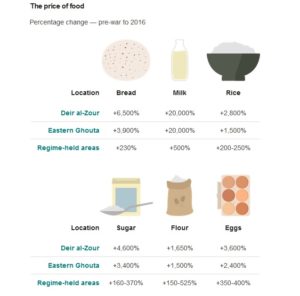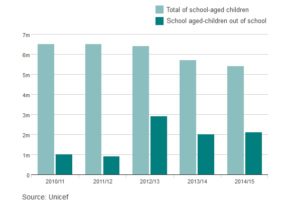March 15 marked five years since the beginning of the Syrian conflict. What started as a peaceful protest against President Bashar al-Assad in 2011, soon developed into a brutal civil war that fueled the rise of Islamic State of Iraq and Syria (ISIS). It claimed the lives of more than a quarter of a million people, caused the biggest refugee crisis since World War II, and almost signaled World War III.
The Syrian Center for Policy Research estimates that 470,000 Syrians have died — 400,000 by violence and 70,000 died due to lack of adequate medical care —over the course of Syria’s five-year-long civil war; the figure is almost double the United Nations’ last count of 250,000, in 2014.
As of February 2016, the United Nations has identified 13.5 million Syrians are in need of humanitarian assistance — 6.6 million of which are internally displaced by violence, and over 4.6 million have fled the country. About 17.9 million people still live in Syria — down from 24.5 million before the war broke out. A whole generation of Syrian children — more than 3.5 million under the age of five — has never experienced anything but war.
While most would know how the Syrian conflict turned into an international proxy war, not many have an idea how it affected those 18 million people who still live in the war-torn country.
An economy in tatters
According to World Vision estimates, the cost of conflict to Syria to date is an estimated $275 billion – about 150 times the Syrian health budget prior to conflict taking hold in 2011. Real GDP per capita is around 45% lower than it would have been in the absence of conflict. Even if the conflict ends this year, the cost of the conflict will grow to between $448 and $689 billion in terms of lost growth. The cost of conflict will amount to $1.3 trillion if the conflict continues until 2020.
Nearly 70% of the population is living in extreme poverty; with unemployment estimated to be running at over 50% (up from 14% in 2011), people are unable to secure basic food and non-food items.
Food as a weapon of war
Although, international laws prohibit the use of starvation against civilians, forces on all sides are preventing aid from reaching hardest hit blockaded areas in Syria.
UN Secretary-General Ban Ki-moon recently told the general assembly, “Humanitarian teams who recently entered a besieged Syrian town witnessed scenes that “haunt the soul”. The use of food as a weapon of war is a war crime.”
Aid workers in Madaya described seeing skeletal figures; children who could barely talk or walk, and parents who gave their kids sleeping pills to calm their hunger. Pro-government fighters in Fouaa and Kfarya said some residents are eating grass to survive. CNN reported that a kilogram of rice could easily sell for more than $100 in some places, and milk may cost as much as $300 per liter. In the besieged city of Deir ez-Zor, food prices rose 978% in the last year.
“Every day we received a child from one of the schools around the hospitals suffering from a coma because of lack of nutrition. What would you say to a mother when she came to a hospital to take her son after such an incident? When she cannot feed herself, how can she find food for her kids? The very basic needs became a luxury now in Syria,” Dr. Mohamed Katoub, trying to keep a hospital running in a war zone, told NBC News.
Hospitals destroyed, healthcare collapsed
Between the start of the war in March 2011 and November 2015, Physicians for Human Rights documented 336 attacks on at least 240 medical facilities across the country. These attacks resulted in the deaths of 697 medical personnel. Attacks on hospitals have left only 43% of Syrian hospitals functional, even as half the total number of certified doctors has fled the country. Estimated life expectancy at birth has dropped by 15 years during the five-year span of the conflict. Millions of children under 5 are now more vulnerable than ever to physical trauma, injuries, communicable diseases and malnutrition.
Education system shattered, outlook bleak
World Vision notes that direct and indirect impacts on education services resulted in the equivalent of 24.5 million years of lost schooling by the end of 2015. With one in every four schools damaged, destroyed or used to shelter displaced people, about 5.7 million children inside Syria are in need of education assistance. There were 400,000 more children out of school in 2015 than 2014. Almost one quarter of the country’s teaching personnel — some 52,500 teachers — no longer in their posts.
Almost all of Syria’s UNESCO World Heritage sites – such as Aleppo, the Crac des Chevaliers and the ancient town of Bosra – have been either damaged or destroyed. The Islamic State destroyed many of its Roman-era relics, including the 2000-year-old Temple of Bel and the iconic Arch of Triumph.
Syria is a different country now, but it isn’t lost – yet. Can the once beautiful country emerge from these ruins? With Putin announcing withdrawal of most Russian forces from Syria, coinciding with the resumption of Syria peace talks in Geneva, this doesn’t sound all that far-fetched. Or does it, still? Please share your thoughts in the comment section below…
Thanks for taking the time to read this article. If you found this information helpful, please share it with your friends and family. Your support in our endeavor of sharing free information would be much appreciated.
Follow us on Facebook to stay updated with what's going Viral in the Alternative News scene. https://www.facebook.com/ViralAlternativeNews
This Article (This Is What 5 Years Of War Did To Syria) is free and open source. You have permission to republish this article under a Creative Commons license with attribution to the author and AnonHQ.com.




